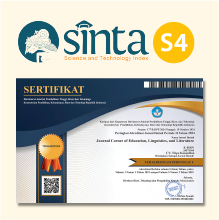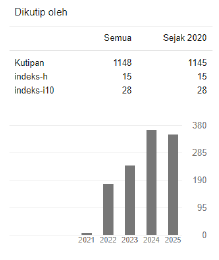Gender Differences in Saudi EFL Undergraduate Students’ Perceptions toward the Impact of Collaborative Writing
 https://doi.org/10.54012/jcell.v4i2.340
https://doi.org/10.54012/jcell.v4i2.340
 Abstract views: 282
Abstract views: 282
 PDF downloads: 166
PDF downloads: 166
Keywords:
collaborative writing, EFL, perceptions, Saudi undergraduate studentsAbstract
Given the importance of collaborative writing, it has been generally investigated and discussed in different educational aspects. Gender difference is a factor that could contribute to the impact of collaborative writing. Therefore, the current study tried to illuminate the perceptions of gender differences among Saudi EFL undergraduate students regarding the effect of collaborative writing on written and social skills. Therefore, the study utilized an online survey adapted from previous studies and modified to fix the statements to the study's aims. The survey was distributed online on Telegram via different channels, and (N = 74 Saudi undergraduate students) attending different universities in Saudi Arabia, with an equal number of 37 females and males, took part in the study. Furthermore, the independent sample t-test was used to analyze the data, and the results showed no statistically significant difference in the perceptions of both genders toward the impact of collaborative writing on both written and social development. These findings suggest further studies in this regard by employing more than one instrument to gain more in-depth data about how gender differences and cultural and educational background might impact the perceptions of students toward collaborative writing.
Downloads
References
Al-Ahmad, S. M. (2003). The impact of collaborative learning on L1 and L2 college
students' apprehension about and attitudes toward writing. Indiana University of
Pennsylvania.
Anshu, A. H., & Yesuf, M. Y. (2022). Effects of collaborative writing on EFL students'
paragraph writing performance: Focus on content and coherence. International
Journal of Education and Literacy Studies, 10(1), 36
https://doi.org/10.7575/aiac.ijels.v.10n.1p.36
Alvarez Sanvicens, U. (2020). Benefits and drawbacks of collaborative writing for young foreign language learners: A case study on teachers' perspective.
http://hdl.handle.net/10810/43317
Alkhalaf, N. A. (2020). Saudi female EFL learners and collaborative writing: Attitudes
and challenges. Theory and Practice in Language Studies, 10(9), 1118
https://doi.org/10.17507/tpls.1009.16
Al-Besher, K. (2012). Developing the writing skills of ESL students through the
collaborative learning strategy (Doctoral dissertation). Newcastle University.
http://hdl.handle.net/10443/1836
Biria, R., & Jafari, S. (2013). The impact of collaborative writing on the writing fluency
of Iranian EFL learners. Journal of Language Teaching & Research, 4(1), 164
https://doi.org/10.4304/jltr.4.1.164-175
Boud, D., Cohen, R., & Sampson, J. (1999). Peer learning and assessment. Assessment
& Evaluation in Higher Education, 24(4), 413
https://doi.org/10.1080/0260293990240405
Bueno-Alastuey, M. C., Vasseur, R., & Elola, I. (2022). Effects of collaborative writing
and peer feedback on Spanish as a foreign language writing performance. Foreign
Language Annals, 55(2), 517-539. https://doi.org/10.1111/flan.12611
Baker, M., Hansen, T., Joiner, R., & Traum, D. (1999). The role of grounding in
collaborative learning tasks. In Collaborative learning: Cognitive and
computational approaches (pp.6371).
Carless, D. (2002). Implementing task-based learning with young learners. ELT Journal, 56(4), 389-396. https://doi.org/10.1093/elt/56.4.389
Farrah, M. (2011). Attitudes towards collaborative writing among English majors in
Hebron University. http://dspace.hebron.edu/xmlui/handle/123456789/68
Galbin, A. (2014). An introduction to social constructionism. Social Research Reports,
(26),8292.
Gousseva-Goodwin, J. V. (2000). Collaborative writing assignments and online
discussions in an advanced ESL composition class (Doctoral dissertation). The
University of Arizona. http://hdl.handle.net/10150/284263
Hadjerrouit, S. (2011). A collaborative writing approach to wikis: Design,
implementation, and evaluation. Issues in Informing Science & Information
Technology, 8, 479-490. http://hdl.handle.net/11250/137909
Hadjerrouit, S. (2016). Assessing the level of collaborative writing in a wiki-based
environment: A case study in teacher education. In Competencies in Teaching,
Learning and Educational Leadership in the Digital Age: Papers from CELDA
(pp. 197-216). Springer. https://doi.org/10.1007/978-3-319-30295-9_12
Jafari, N., & Ansari, D. N. (2012). The effect of collaboration on Iranian EFL learners'
writing accuracy. International Education Studies, 5(2), 125
https://doi.org/10.5539/ies.v5n2p125
Johnson, R., & Johnson, D. (1986). Action research: Cooperative learning in the science classroom. Science and Children, 24(6), 31-32.
Jiang, W., & Eslami, Z. R. (2022). Effects of computer-mediated collaborative writing
on individual EFL writing performance. Computer Assisted Language Learning,
(9), 2701 2730. https://doi.org/10.1080/09588221.2021.1893753
Klemm, W. R. (1994). Using a formal collaborative learning paradigm for veterinary
medical education. Journal of Veterinary Medical Education, 21(1), 2-6.
Kollar, I., & Fischer, F. (2010). Peer assessment as collaborative learning: A cognitive
perspective. Learning and Instruction, 20(4), 344
https://doi.org/10.1016/j.learninstruc.2009.08.005
Larson-Hall, J. (2016). A guide to doing statistics in second language research using
SPSS and R. Routledge. https://doi.org/10.4324/9781315775661
Mulligan, C., & Garofalo, R. (2011). A collaborative writing approach: Methodology
and student assessment. The Language Teacher, 35(3), 5
https://doi.org/10.37546/JALTTLT35.3-1
Hadjerrouit, S. (2016). Assessing the level of collaborative writing in a wiki-based
environment: A case study in teacher education. Competencies in Teaching,
Learning and Educational Leadership in the Digital age: Papers from CELDA
(pp. 197-216). Springer. https://doi.org/10.1007/978-3-319-30295-9_12
Jafari, N., & Ansari, D. N. (2012). The Effect of Collaboration on Iranian EFL Learners' Writing Accuracy. International Education Studies, 5(2), 125
https://doi.org/10.5539/ies.v5n2p125
Johnson, R., & Johnson, D. (1986). Action Research: Cooperative Learning in the
Science Classroom. Science and Children, 24(6), 31-32.
Jiang, W., & Eslami, Z. R. (2022). Effects of computer-mediated collaborative writing
on individual EFL writing performance. Computer Assisted Language Learning,
(9), 27012730. https://doi.org/10.1080/09588221.2021.1893753
Klemm, W. R. (1994). Using a Formal Collaborative Learning Paradigm for Veterinary Medical Education. Journal of Veterinary Medical Education, 21(1), 2-6.
Kollar, I., & Fischer, F. (2010). Peer assessment as collaborative learning: A cognitive
perspective. Learning and Instruction, 20(4), 344
https://doi.org/10.1016/j.learninstruc.2009.08.005
Larson-Hall, J. (2016). A guide to doing statistics in second language research using
SPSS and R. Routledge. https://doi.org/10.4324/9781315775661
Mulligan, C., & Garofalo, R. (2011). A collaborative writing approach: Methodology
and student assessment. The Language Teacher, 35(3), 5
https://doi.org/10.37546/JALTTLT35.31
Nokes-Malach, T. J., Richey, J. E., & Gadgil, S. (2015). When is it better to learn
together? Insights from research on collaborative learning. Educational
Psychology Review, 27(4), 645-656. https://doi.org/10.1007/s10648-015-9312-8
Pham, V. P. H. (2021). The effects of collaborative writing on students' writing fluency:
An efficient framework for collaborative writing. Sage Open, 11(1),
https://doi.org/10.1177/2158244021998363
Ubilla Rosales, L., Gómez Álvarez, L., Sáez Carrillo, K., & Etchegaray Pezo, P. (2020). Collaborative writing of argumentative essays in an EFL blended course: Chilean preservice teachers' perceptions and self-assessment. Íkala, revista de lenguaje y cultura, 25(2), 307-327. https://doi.org/10.17533/udea.ikala.v25n02a10
Sa'diyah, H., & Nabhan, S. (2021). Collaborative writing using Google Docs in an EFL classroom: Voices from high school students. VELES: Voices of English Language Education Society, 5(2), 156-166. https://doi.org/10.29408/veles.v5i2.3863
Smith, B. L., & MacGregor, J. T. (1992). What is collaborative learning? In A. Goodsell, M. Maher, V. Tinto, & Associates (Eds.), Collaborative learning: A sourcebook for higher education (pp. 10-16). National Center on Postsecondary Teaching, Learning, and Assessment.
Storch, N. (2013). Collaborative writing in L2 classrooms (Vol. 31). Multilingual
Matters. https://doi.org/10.21832/9781847699954
Storch, N. (2005). Collaborative writing: Product, process, and students' reflections.
Journal of Second Language Writing, 14(3), 153
https://doi.org/10.1016/j.jslw.2005.05.002
Storch, N. (1999). Are two heads better than one? Pair work and grammatical accuracy. System, 27(3), 363-374. https://doi.org/10.1016/S0346-251X(99)00031-7
Sukirman, S. (2016). Using collaborative writing in teaching writing. Langkawi: Journal of The Association for Arabic and English, 2(1), 33 46. https://ejournal.iainkendari.ac.id/index.php/langkawi/article/view/443
Suwantarathip, O., & Wichadee, S. (2014). The Effects of Collaborative Writing
Activity Using Google Docs on Students' Writing Abilities. Turkish Online
Journal of Educational Technology-TOJET, 13(2), 148-156.
Trinidad Tagle, L., & Victoria A. Cabigan, Ma. (2022). Online Collaborative Learning
to The Learners’ Performance and Attitude. International Journal of Research
Publications,105(1).
Watanabe, Y. (2008). Peer-peer interaction between L2 learners of different proficiency
levels:Their interactions and reflections. Canadian Modern Language Review,
(4), 605635. https://doi.org/10.3138/cmlr.64.4.605
Woodrich, M. P., & Fan, Y. (2017). Google Docs as a tool for collaborative writing in
the middle school classroom. Journal of Information Technology Education:
Research, 16,391413. https://doi.org/10.28945/3773
Zulfikar, Z., & Aulia, C. T. (2020). Exploring Acehnese EFL College Students'
Perceptions on Collaborative Writing. Wanastra: Jurnal Bahasa dan Sastra,
(2), 171 180. https://doi.org/10.31294/w.v12i2.8579
Downloads
Published
How to Cite
Issue
Section
License
Copyright (c) 2024 Layan Ali Alrayes

This work is licensed under a Creative Commons Attribution-ShareAlike 4.0 International License.
All articles published in the Journal Corner of Education, Linguistics, and Literature are licensed under the Creative Commons Attribution-ShareAlike License (CC BY-SA).

















